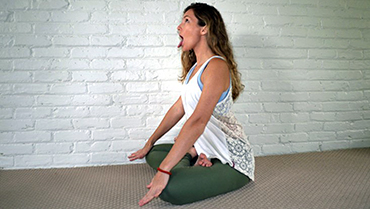Lion Pose - Simhasana

Contents
The Lion Pose, or Roaring Lion Pose (whose original Indian name is Simhasana) in yoga is suitable for people of all ages, as it is relatively easy to perform. ‘Simha’ in Sanskrit means, Lion, and this posture gets its name because the face of the person performing it resembles the face of a Roaring Lion (Simha Mudra), with open mouth and extended tongue.
Lion Pose is considered a base pose as lion pose variations can be derived from this pose.
Pose Detail
- Difficulty: Advanced, Beginners, Intermediate
- By Type: Meditation Yoga Poses
- Body Position: Seated Yoga Poses
- By Benefit: Yoga Poses For Anxiety And Panic Attack, Yoga Poses For Stress Relief, Yoga Poses For Weight Loss
Step-by-Step Instructions
Benefits and Contraindications
Relieves tension in the chest and face.
An often-overlooked benefit of Simhasana is that it stimulates the platysma, a flat, thin, rectangular-shaped muscle on the front of the throat. The platysma, when contracted, pulls down on the corners of the mouth and wrinkles the skin of the neck.
Simhasana helps keep the platysma firm as we age.
According to traditional texts, Simhasana destroys disease and facilitates the three major bandhas (Mula, Jalandhara, Uddiyana).
If you have a knee injury, always be cautious in flexed-knee sitting positions and, if necessary, sit on a chair to do the pose.
Photo poses in different angles

Tips
The hands and shoulder blades are sympathetically connected. As you spread the right palm on the right knee, feel how the shoulder blade spreads across your back. Similarly, as you press each palm against the same-side knee, feel how the same-side shoulder blade presses more deeply into the back, helping to lift the heart.
Frequently Asked Questions
Modifications & Variations
- Lion Pose II
- Lion Pose Hands Under Legs
- Lion Pose Lotus Legs
- Lion Pose Close Up
Top Preparatory Poses
- Bound Angle Pose
- Staff Pose
- Easy Pose
- Reclining Hero Pose
- Reclining Bound Angle Pose
- Hero Pose